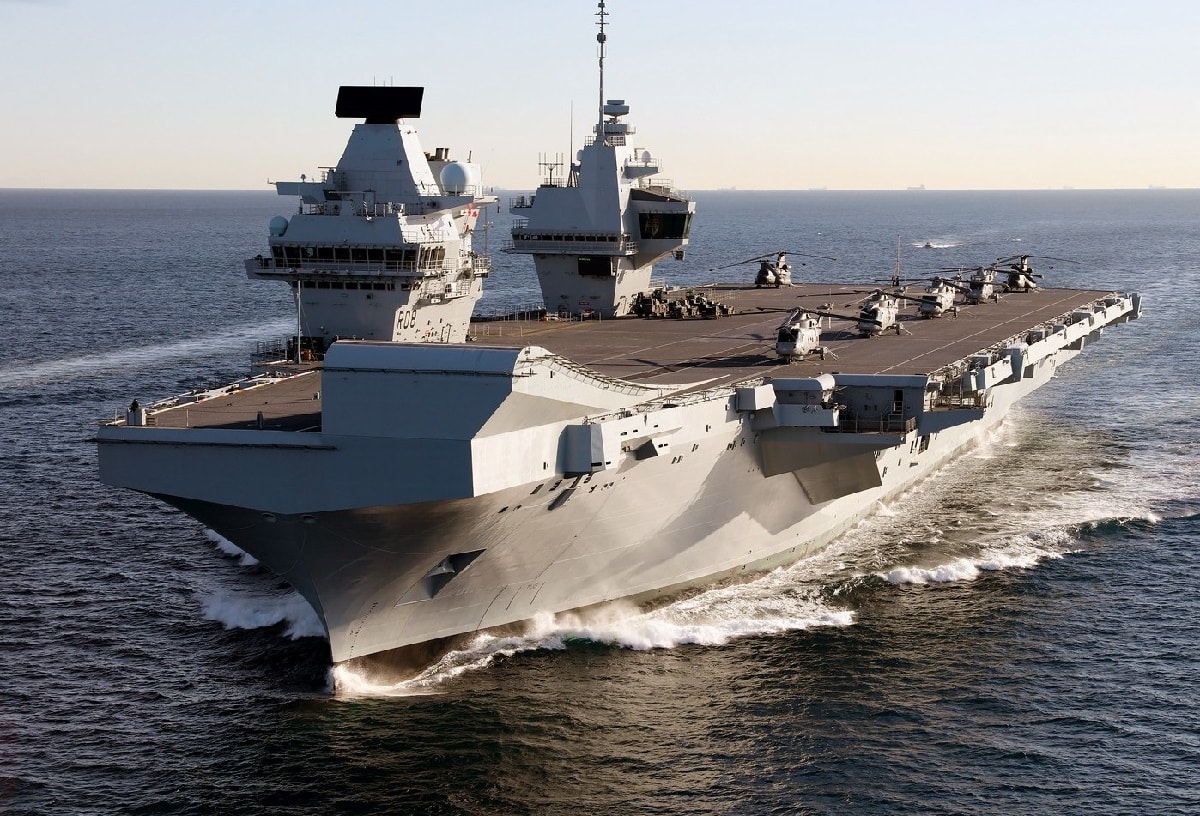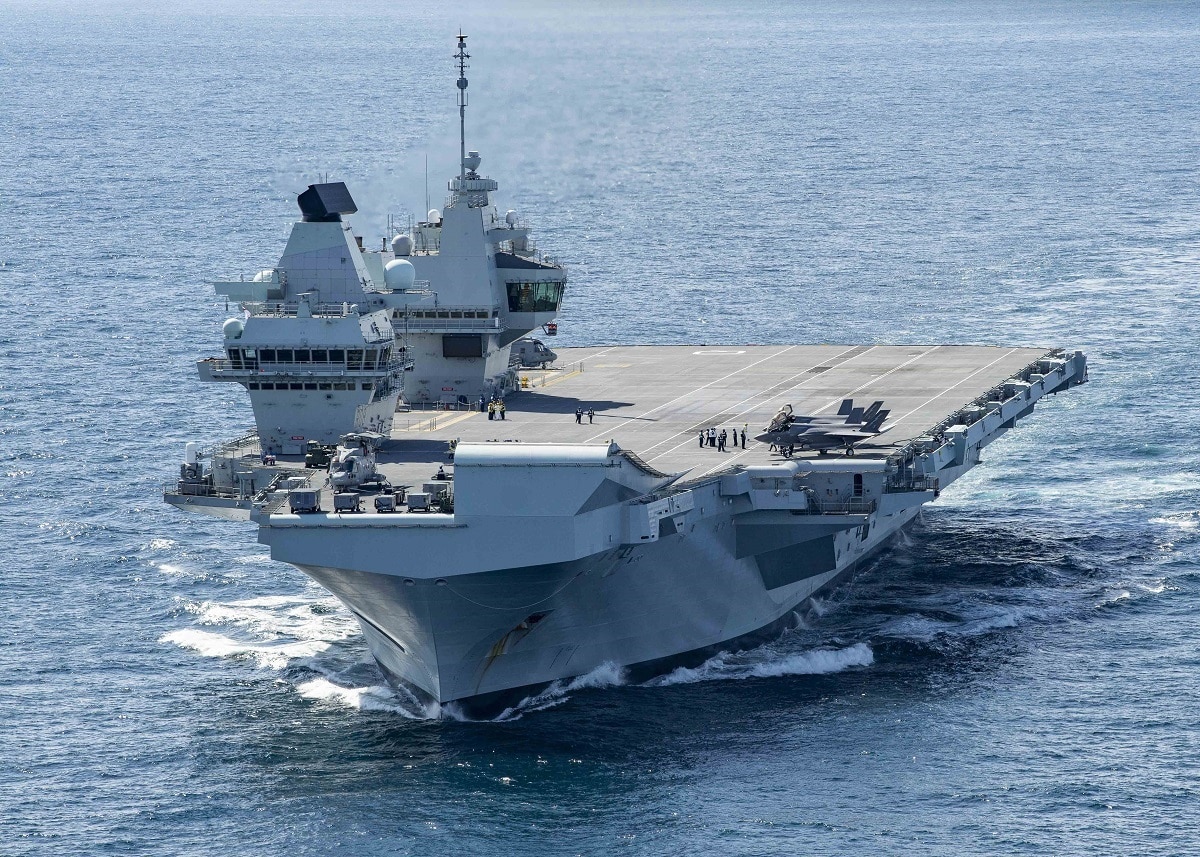The HMS Queen Elizabeth, the lead ship of the Queen Elizabeth-class aircraft carriers, was designed to be a significant leap in naval engineering and capability for the Royal Navy. Commissioned in December 2017, this vessel, along with its sister ship HMS Prince of Wales, forms the backbone of the UK’s Carrier Strike Group, projecting British naval power across the globe.
However, despite its impressive appearance, the HMS Queen Elizabeth has faced several challenges since its inception, ranging from mechanical issues to operational setbacks.
The Crown Jewel of the British Navy?
The HMS Queen Elizabeth was meant to stand as a testament to modern naval architecture. On paper, the aircraft carrier looks rather impressive. With a displacement of approximately 65,000 tons, it is one of the largest warships ever built for the Royal Navy.
The carrier features a unique twin-island design, which separates the navigation and flight control operations, enhancing operational efficiency and survivability.
The flight deck, equipped with a 12-degree ski jump, is designed to launch F-35B Lightning II stealth fighters, providing a formidable air combat capability.
The ship’s propulsion system is powered by two Rolls-Royce Marine Trent MT30 gas turbines and four Wärtsilä diesel generators, delivering a combined power output of 118.4 MW. This integrated electric propulsion system allows the carrier to reach speeds in excess of 25 knots and operate over a range of 10,000 nautical miles without refueling.
The HMS Queen Elizabeth can carry up to 40 aircraft, including a mix of fixed-wing and rotary-wing platforms, making it a versatile asset for various military operations.
Sailing All over the World
Since its commissioning, the HMS Queen Elizabeth has been involved in numerous high-profile deployments.
Its first global deployment in 2021 saw the carrier lead the UK Carrier Strike Group across the Atlantic, Indian, and Pacific Oceans, demonstrating the Royal Navy’s return to global carrier operations.
This deployment included joint exercises with allied navies, showcasing the carrier’s interoperability and strategic importance.
The HMS Queen Elizabeth Struggles to Remain Combat Ready
Despite its impressive appearance, the HMS Queen Elizabeth has encountered several problems that have hindered its operational effectiveness.
These issues can be attributed to mechanical failures, deployment delays, and logistical challenges.
One of the most persistent issues has been mechanical failures, particularly related to the propulsion system.
In February 2024, routine pre-sailing checks revealed a problem with the starboard propeller shaft coupling, preventing the carrier from participating in NATO’s Exercise Steadfast Defender. This issue is not isolated; similar problems have plagued its sister ship, HMS Prince of Wales, which also faced propeller shaft issues in 2022.
Mechanical failures have often led to significant deployment delays. For instance, the HMS Queen Elizabeth’s inability to participate in Exercise Steadfast Defender required the HMS Prince of Wales to take its place, highlighting the operational impact of these technical issues. Such delays not only affect the carrier’s readiness but also strain the Royal Navy’s overall operational schedule.
The effectiveness of an aircraft carrier is heavily dependent on its air wing. The HMS Queen Elizabeth has faced a critical shortage of F-35B aircraft, limiting its ability to project air power effectively.
The shortage in aircraft is largely due to their staggeringly high costs. The F-35B cost around $135.8 million per unit, making it extremely difficult to purchase in large quantities. For a carrier that’s more or less designed to carry F-35s, this is a staggering setback. This shortage is compounded by budgetary constraints and delays in aircraft deliveries, which have hampered the carrier’s operational capabilities.
The survivability of an aircraft carrier in high-threat environments relies on a robust escort fleet. The Royal Navy has struggled with a lack of escort ships, which limits the HMS Queen Elizabeth’s ability to operate in contested waters.
This shortage of support elements poses a significant risk to the carrier’s operational effectiveness and overall mission success.
The development and maintenance of advanced naval platforms like the HMS Queen Elizabeth are costly endeavors. Budgetary constraints have often led to delays in maintenance and upgrades, exacerbating existing issues and preventing timely resolution of technical problems. Ensuring adequate funding is crucial for maintaining the carrier’s operational readiness and addressing its persistent challenges.

HMS Queen Elizabeth-Class Aircraft Carrier.
What Should be Done with the HMS Queen Elizabeth?
The HMS Queen Elizabeth remains a cornerstone of the Royal Navy’s strategic capabilities, despite the challenges it faces.
Addressing these issues requires a multifaceted approach, including increased investment in maintenance and upgrades, timely delivery of aircraft, and bolstering the escort fleet. The Royal Navy’s commitment to resolving these problems will be critical in ensuring that the HMS Queen Elizabeth can fulfill its role as a global power projection platform.
In conclusion, the HMS Queen Elizabeth was intended to be a modern marvel of naval engineering, embodying the Royal Navy’s aspirations for a formidable carrier strike capability.
However, the persistent challenges it faces highlight the complexities of operating such advanced platforms.
By addressing these issues, the Royal Navy can ensure that the HMS Queen Elizabeth continues to serve as a symbol of British naval power and a key asset in maintaining global maritime security.
About the Author Isaac Seitz
Isaac Seitz, a 19FortyFive Defense Columnist, graduated from Patrick Henry College’s Strategic Intelligence and National Security program. He has also studied Russian at Middlebury Language Schools and has worked as an intelligence Analyst in the private sector.

